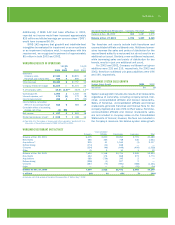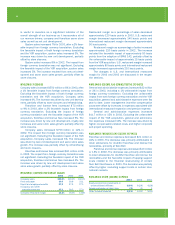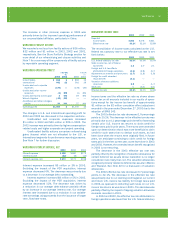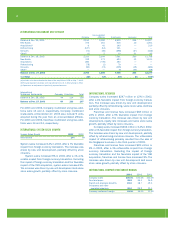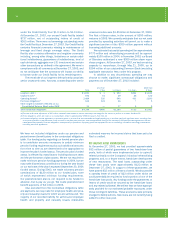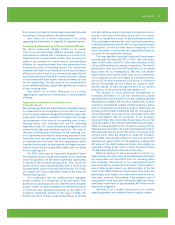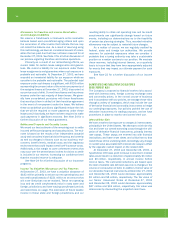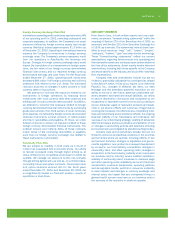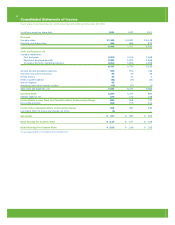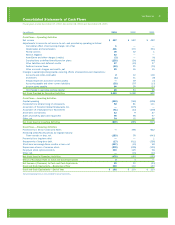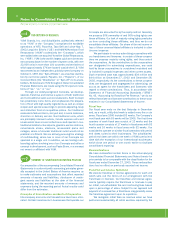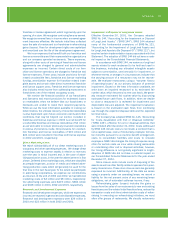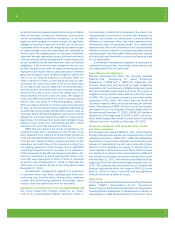Pizza Hut 2003 Annual Report Download - page 46
Download and view the complete annual report
Please find page 46 of the 2003 Pizza Hut annual report below. You can navigate through the pages in the report by either clicking on the pages listed below, or by using the keyword search tool below to find specific information within the annual report.
44.
increase, respectively, our 2004 pension plan expense by
approximately $4 million.
The losses our plan assets have experienced, along
with the decrease in discount rates, have largely contrib-
uted to the unrecognized actuarial loss of $230 million
in our plans as of September 30, 2003. For purposes of
determining 2003 expense our funded status was such
that we recognized $6 million of unrecognized actuarial
loss in 2003. We will recognize approximately $19 million
of unrecognized actuarial loss in 2004. Given no change to
the assumptions at our September 30, 2003 measurement
date, actuarial loss recognition will remain at an amount
near that to be recognized in 2004 over the next few years
before it begins to gradually decline.
In total, we expect pension expense to increase
approximately $14 million to $54 million in 2004. We have
incorporated this incremental expense into our operating
plans and outlook. The increase is driven by the recognition
of actuarial losses as discussed in the preceding paragraph
and an increase in interest cost because of the higher PBO.
Service cost will also increase as a result of the lower
discount rate, though, as previously mentioned, the plans
are closed to new participants. A 50 basis point change in
our discount rate assumption of 6.25% at September 30,
2003 would impact our 2004 pension expense by approxi-
mately $11 million.
We do not believe that the underfunded status of the
pension plans will materially affect our financial position or
cash flows in 2004 or future years. Given current funding
levels and discount rates we would anticipate making contri-
butions to fully fund the pension plans over the course of
the next five years. We believe our cash flows from oper-
ating activities of approximately $1 billion per year are
sufficient to allow us to make necessary contributions to
the plans, and anticipated fundings have been incorporated
into our cash flow projections. We have included known
and expected increases in our pension expense as well as
future expected plan contributions in our operating plans
and outlook.
Avian Flu
In several Asian markets, including Thailand, Taiwan,
South Korea, Japan, Indonesia, Malaysia, Singapore and
certain sections of China, avian flu has impacted retail
sales trends and sales trends at KFC through March 5,
2004. Based on information as of March 5, 2004, the
Company believes that the most likely effect of avian flu
outbreaks in these markets, some of which are completely
franchised markets, will be short term. Additionally, the
Company currently does not expect that the avian flu
outbreak will materially affect its chicken supply in Asia or
other markets.
Our most significant market that has been affected by
the avian flu is China. As we have previously stated, if the
avian flu outbreak were to affect the entire country of China
for up to two months (through the end of March 2004) with
sales declines in the range of 20% at KFC, 2004 diluted EPS
results for the Company would be unfavorably impacted by
up to $0.02. We have incorporated this potential unfavorable
impact in our operating plans and outlook.
AmeriServe and Other Charges (Credits)
During 2004, we expect to recover approximately $10 million
related to recoveries from the AmeriServe bankruptcy reor-
ganization process. We expect that this will substantially
complete our recoveries related to the AmeriServe bank-
ruptcy reorganization process. See Note 7 for a detailed
discussion of AmeriServe and other charges (credits).
CRITICAL ACCOUNTING POLICIES
Our reported results are impacted by the application of
certain accounting policies that require us to make subjec-
tive or complex judgments. These judgments involve
estimations of the effect of matters that are inherently
uncertain and may significantly impact our quarterly or
annual results of operations or financial condition. Changes
in the estimates and judgements could significantly affect
our results of operations, financial condition and cash flows
in future years. A description of what we consider to be our
most significant critical accounting policies follows.
Impairment or Disposal of Long-Lived Assets
We evaluate our long-lived assets for impairment at the
individual restaurant level. Restaurants held and used are
evaluated for impairment on a semi-annual basis or when-
ever events or circumstances indicate that the carrying
amount of a restaurant may not be recoverable (including
a decision to close a restaurant). Our semi-annual test
includes those restaurants that have experienced two
consecutive years of operating losses. These impairment
evaluations require an estimation of cash flows over the
remaining useful life of the primary asset of the restaurant,
which can be for a period of over 20 years, and any terminal
value. We limit assumptions about important factors such
as sales growth and margin improvement to those that are
supportable based upon our plans for the unit and actual
results at comparable restaurants.
If the long-lived assets of a restaurant on a held and
used basis are not recoverable based upon forecasted,
undiscounted cash flows, we write the assets down to their
fair value. This fair value is determined by discounting the
forecasted cash flows, including terminal value, of the
restaurant at an appropriate rate. The discount rate used
is our cost of capital, adjusted upward when a higher risk
is believed to exist.
When it is probable that we will sell a restaurant,
we write down the restaurant to its fair value. We often
refranchise restaurants in groups and therefore perform
impairment evaluations at the group level. Fair value is
based on the expected sales proceeds less applicable
transaction costs. Estimated sales proceeds are based
on the most relevant of historical sales multiples or bids



